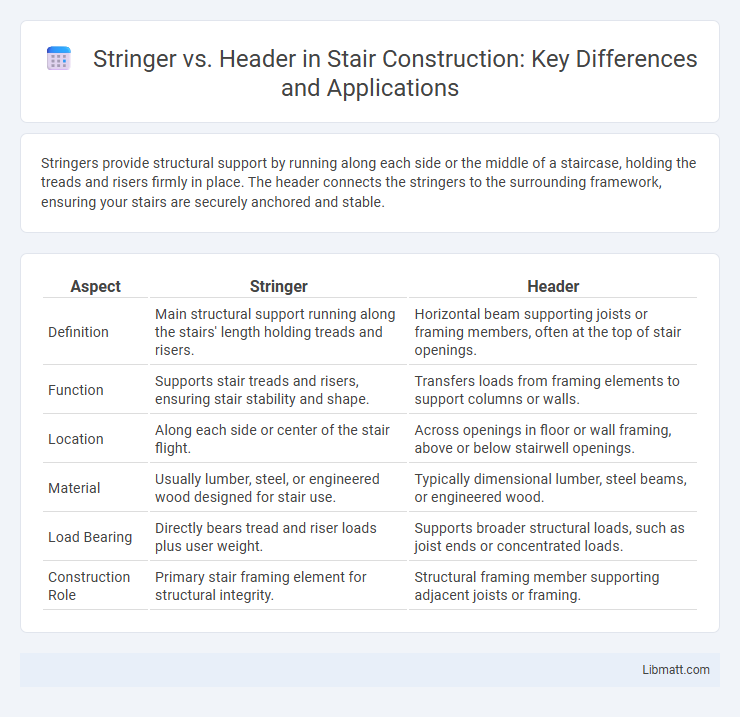Stringers provide structural support by running along each side or the middle of a staircase, holding the treads and risers firmly in place. The header connects the stringers to the surrounding framework, ensuring your stairs are securely anchored and stable.
Table of Comparison
| Aspect | Stringer | Header |
|---|---|---|
| Definition | Main structural support running along the stairs' length holding treads and risers. | Horizontal beam supporting joists or framing members, often at the top of stair openings. |
| Function | Supports stair treads and risers, ensuring stair stability and shape. | Transfers loads from framing elements to support columns or walls. |
| Location | Along each side or center of the stair flight. | Across openings in floor or wall framing, above or below stairwell openings. |
| Material | Usually lumber, steel, or engineered wood designed for stair use. | Typically dimensional lumber, steel beams, or engineered wood. |
| Load Bearing | Directly bears tread and riser loads plus user weight. | Supports broader structural loads, such as joist ends or concentrated loads. |
| Construction Role | Primary stair framing element for structural integrity. | Structural framing member supporting adjacent joists or framing. |
Understanding Stair Stringers and Headers
Stair stringers are the diagonal structural supports running along each side of a staircase, directly bearing the weight of the treads and risers. Headers serve as horizontal beams at the top and bottom of the stair framing, providing anchorage points and distributing loads to adjoining framing members. Proper installation of stair stringers and headers ensures stability, safety, and adherence to building codes for staircase construction.
Definition of a Stair Stringer
A stair stringer is a structural component that supports the treads and risers of a staircase, running along each side or in the center of the stairs. It is typically made from wood, metal, or engineered materials and is designed to bear the load and maintain staircase stability. Unlike headers, which are horizontal beams supporting loads above openings, stringers specifically accommodate the stepped profile of stairs.
Definition of a Stair Header
A stair header is a horizontal support beam that spans the top of a stair opening, providing structural integrity by carrying the load between the stair stringers and the surrounding framework. Unlike stringers, which are inclined boards supporting each tread and riser, the header acts as a crucial tie-in point for securing the stair assembly to the floor or framing above. Ensuring your stair header is properly sized and installed is essential for maintaining the overall safety and durability of your staircase.
Roles of Stringers in Stair Construction
Stringers serve as the primary structural support in stair construction, running along each side or the center to hold the treads and risers securely. They transfer the load from the steps to the ground or landing, ensuring stability and safety. Properly designed stringers prevent sagging and maintain staircase integrity over time.
Function of Headers in Stair Framework
Headers in stair frameworks serve as critical horizontal supports that transfer loads from stair stringers to adjacent structures, ensuring stability and load distribution. They typically span between beams or walls, anchoring the stair assembly and preventing excessive deflection or movement under weight. Properly designed headers contribute to the overall structural integrity and safety of stair systems by maintaining alignment and supporting dynamic loads during use.
Key Differences Between Stringers and Headers
Stringers in stairs are the inclined boards that support the treads and risers, running along each side or the center of the staircase. Headers, by contrast, are horizontal framing members that span openings and provide structural support to joists or stringers above. The key difference lies in their orientation and function: stringers act as the main stair support in an angled position, while headers serve as cross beams reinforcing the stair framework horizontally.
Materials Used for Stair Stringers vs. Headers
Stair stringers are commonly made from durable materials like pressure-treated lumber, engineered wood, or steel to provide structural support for stair treads, while headers are typically constructed from heavier, thicker lumber such as doubled-up 2x12s or steel beams to bear the load of the stair assembly on the framing structure. Your choice of materials for stringers and headers depends on factors such as load requirements, environmental exposure, and design preferences. Using appropriate materials for each component ensures the longevity and safety of the staircase.
Installation Process: Stringers vs. Headers
The installation process for stringers involves precise measurement and cutting of individual supports that follow the staircase slope, requiring accurate alignment for each step. Headers, in contrast, serve as horizontal beams supporting the stringers and are installed first to provide a secure anchor point, demanding robust structural connections to the framing. Proper coordination between header installation and stringer attachment is crucial to ensure stability and compliance with building codes.
Common Mistakes When Working With Stringers and Headers
Common mistakes when working with stringers and headers include miscalculating load-bearing capacity, leading to structural instability in stairs. Incorrect measurements of stringer notches can cause uneven tread depths and riser heights, compromising safety. Failure to properly secure headers may result in inadequate support, increasing the risk of stair movement or collapse.
Choosing the Right Component for Your Stair Design
Selecting the right stair component between a stringer and a header depends on your stair design's structural and aesthetic requirements. Stringers, which run along the sides or center of the stairs, provide essential support for treads and risers and are ideal for traditional staircases, while headers serve as horizontal beams that support the top of the stair assembly and are commonly used in framing to secure stair components in place. Understanding the load distribution and visual impact of each element ensures your stairway is both safe and visually appealing.
Stringer vs Header (stairs) Infographic

 libmatt.com
libmatt.com